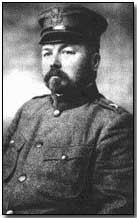Primary Documents - General Funston on Military Operations in Mexico, 15 April 1916
 From March-June 1916 the
United States mounted an armed expedition to Mexico to quell raids initiated
by prominent Mexican leader Pancho Villa into the U.S.
From March-June 1916 the
United States mounted an armed expedition to Mexico to quell raids initiated
by prominent Mexican leader Pancho Villa into the U.S.
Allegedly sponsored by the German government Villa launched a raid into the State of Chihuahua on 11 January 1916, capturing and killing 19 U.S. citizens. This was followed on 9 March with a raid upon Columbus in New Mexico, killing 11 citizens.
Following U.S. protests Mexico's President Venustiano Carranza undertook to deal with Villa but insisted that the U.S. not interfere. However with the U.S. rapidly losing patience with Carranza, General Frederick Funston - U.S. commander along the border - was ordered to despatch an armed U.S. column into Mexico in pursuit of Villa (to be taken dead or alive). To that end Funston placed General John Pershing in command of the expedition.
Pershing led 4,000 U.S. troops into Mexico on 15 March 1916, remaining there until early 1917. On 29 March 1916 a U.S. force of 400 men defeated a larger number of Villa's followers. Nevertheless U.S. troops remained to mop up the remnants of Villa's supporters; these troops increasingly came into contact - and armed conflict - with official Mexican troops sent by President Carranza to deal with Villa, the first of which took place on 12 April 1916.
Increasing clashes led to a very real threat of war between the U.S. and Mexico; on 18 June 1916 U.S. President Woodrow Wilson called out the National Guard to deal with the Mexican problem. As these were gathering along the Mexican border President Carranza backed down, releasing a group of captured U.S. troops and despatching a note of apology on 4 July 1916, in which he suggested convening a conference to prevent future issues.
Reproduced below is General Funston's official report regarding operations in Mexico. Click here to read General Pershing's official report. Click here to read Newton Baker's statement on the calling up of the National Guard. Click here to read Mexican President Carranza's formal letter of complaint to the U.S. government. Click here to read the U.S. government's response.
Official Report on the Mexican Attack at Parral by General Frederick Funston
Frank Tompkins's column, Troop K, Thirteenth Cavalry, and Troop M, Thirteenth Cavalry, entered Parral 11 a.m., 12th instant. Proceeding was cordially received by higher civil and military authorities. Military Commander General Lozano accompanied Major Frank Tompkins on way to camp.
In the outskirts of the town groups of native troops and civilians, following, jeered, threw stones, and fired on column. Major Frank Tompkins took defensive position north of railroad, but was soon flanked by native troops and forced to further retire.
About 300 Carranza troops joined in pursuit, and Major Frank Tompkins continued to withdraw to avoid further complications until he reached Santa Cruz, eight miles from Parral.
Fighting ceased about fifteen miles from town. Major Frank Tompkins deserves great praise for his forbearance. General Lozano attempted to control his men when fight first began, but failed to.
Colonel Brown, with Major Charles Young, Tenth Cavalry, squadron of Tenth Cavalry, eight miles away when notified, and joined Major Frank Tompkins 7 p.m. Reported privately forty Mexicans killed, all soldiers, including one major. One civilian wounded. Americans killed, two; wounded, six; missing, one.
Major R. L. Howze, Eleventh Cavalry, arrived Parral yesterday from San Berja and Ballesea, having had several skirmishes with Villa men. One man killed, two wounded.
Source: Source Records of the Great War, Vol. IV, ed. Charles F. Horne, National Alumni 1923
Flak was a term used to describe anti-aircraft fire.
- Did you know?
